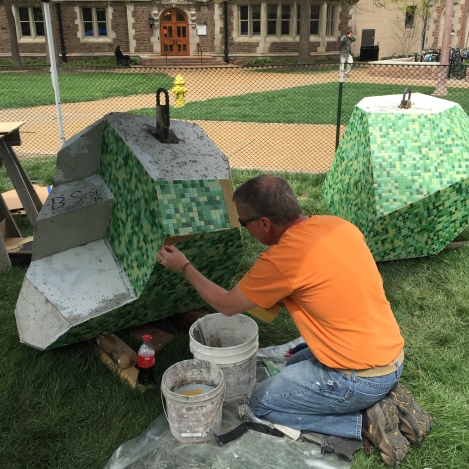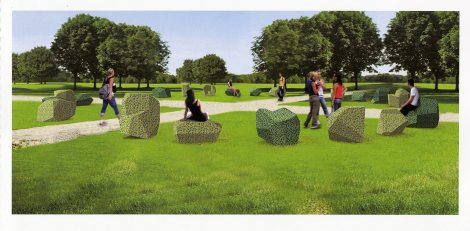About a year ago, a large slab of rock and a seated humanoid form composed of letters from nine alphabets appeared outside the south entrance to the newly minted Bauer Hall. This artwork, Ainsa I by Spanish artist Jaume Plensa, was the first artwork in the relatively new Art on Campus program. The Art on Campus program, overseen by Leslie Markle, curator for public art at the Mildred Lane Kemper Art Museum, uses a percent-for-art model to fund permanent art installations across campus. The other completed Art on Campus project is a set of two light boxes installed in Umrath Hall titled East Meets West by Spencer Finch. (You may have heard Finch’s name in connection with the National September 11 Memorial Museum. His site-specific artwork Trying to Remember the Color of the Sky on That September Morning hangs in the Museum entry).
The third Art on Campus project, currently in the process of being installed, comes from Turkish artist Ayşe Erkmen, who divides her time between Istanbul and Berlin. The artwork, Places, consists of 9 concrete forms (we’ve been calling them “monoliths”) placed in a half circle on the lawn outside Samuel Cupples Hall II. The location is a highly-trafficked area linking Olin Library to Cupples II (the home of the College of Art & Sciences) and buildings associated with the School of Engineering and Applied Science. This confluence of people and physical space informs the artistic choices. As in works such as Plan B (created for the 54th Venice Biennale in 2011), Points de Vue (2003), and Warm Benches (1997), Places originates and intervenes in the social and spatial environment.
The artwork craves interaction. And so far, so good. Students, faculty, staff, and visitors to campus have taken notice of the mysterious concrete monoliths. Curious pedestrians slow down and some stop to ask the installation crew what is going on. Currently, three tile setters are working to painstakingly cover the monoliths in greenish colored mosaics. When finished, the artwork will be “aesthetic and functional,” in the artist’s words. The rock- or crystal-like forms are intended to be used—to be sat or leaned on, slept on, or whatever other creative uses the Wash U community can come up with. Aesthetically, too, “these iconic shapes, as objects, also represent unknown forms that are open to interpretation.” The meaning of the artwork originates and evolves in the context of the daily foot traffic.
The tiling and final placement of the monoliths will be complete in the next few weeks.
By Allison Fricke, assistant educator


